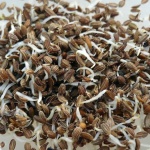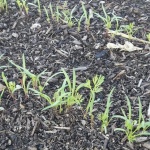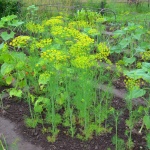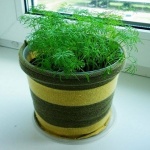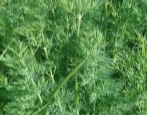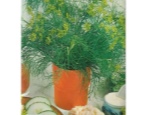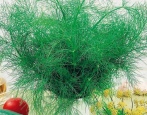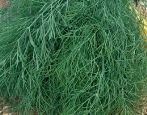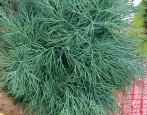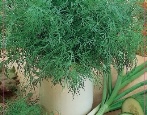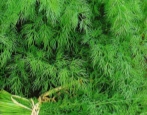
- Year of approval: 1974
- Leaf rosette: standing
- Ripening terms: early maturing
- The period from germination to biological ripeness (harvesting with spices): 70 days
- Leaf size: large
- Leaf color: dark green, with a bluish tint
- Dissection of leaves: strong
- Umbrella size: large
- Number of beams: up to 33
- Plant weight when harvesting for greens, g: 30
Dill Gribovsky is already a middle-aged variety, it is more than four decades old. Over the years, he won the love of many farmers. He is often called a padan, because he scatters seeds near him.
Breeding history
A variety was born in one of the scientific institutes of Russia. In 1974, dill was added to the list of the State Register and became available for mass cultivation.
Description of the variety
The culture is positioned as an independent variety. The plant is annual.
Characteristics of the appearance of the plant
The described type of dill has a standing deciduous rosette, moderate in size. As a rule, there are 5-6 leaves in it. Saturated green large leaves with a bluish tint are covered with a barely noticeable layer of wax. Their length is about 12-20 centimeters. The leaves have a pronounced dissection.
When collecting dill for greens, the mass of Gribovsky is about 30 grams. The culture has a voluminous, with a slight bulge, an umbrella. Its diameter is approximately 18-30 centimeters. In addition, the variety is characterized by multi-beam, each umbrella has up to 33 beams.
Purpose and taste
Dill Gribovsky is universal. It is intended not only for fresh consumption, but also for preparations for the winter, drying, freezing. In addition, the plant is included in the composition of cosmetics, traditional medicines. Tasters rate the sweetish taste of this species on a solid five, additionally focusing on its aroma and delicate texture of the leaves.
Ripening terms
The considered variety is classified as early maturing. From the moment of planting seeds to harvesting for greens, you need to wait approximately 25-35 days, before harvesting for spices - about 70 days. The crop is usually harvested within three months - from June to August. They cut off Gribovsky as needed, a new one can be planted in place of the collected one.
Yield
The described variety shows good productivity. On average, a gardener can get 1 kilogram of dill from one square meter. With proper storage, the culture retains its excellent presentation for a long time.
Growing regions
The geography of Gribovsky cultivation is very extensive. It can be observed in the Far East, in the Urals, in the North Caucasus, in the Central and Central Black Earth regions, in the North, Volga-Vyatka, in the Middle and Lower Volga, in Eastern Siberia, in the North-West region.
Growing and care
The cultivation of dill is started in the spring. The approximate sowing time is from the third decade of April to mid-July. Planting Gribovsky is permissible several times during this period, with a break of a couple of weeks.
On the eve of the process, it is advisable to soak the planting material for a couple of days, regularly changing the water. The seeds are immersed in the ground by 1 centimeter. When planting dill, you should adhere to the scheme: keep a distance between plants of 5-7 centimeters and leave 35 centimeters between the rows.
If a seedling planting method is chosen, the culture is planted in pots, systematically watered for two weeks, and then moved into open ground.
When caring for the variety in question, it needs to be watered often - about a couple of times a week. This procedure will require warm, settled water.
After moistening, the dill is regularly loosened and weeded. If the soil is poor in trace elements, the culture should be fed from time to time with complexes consisting of potassium, nitrogen, superphosphate.
It is worth paying attention to the fact that it is forbidden to huddle dill.
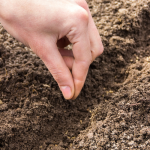
Dill cultivation is available in any conditions: open and closed ground, on a balcony or windowsill. Before planting dill, you need to carry out pre-sowing seed treatment, correctly determine the timing, prepare the beds.
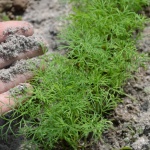
Soil requirements
The culture feels comfortable in loose chernozem soil, light loam, sandy loam saturated with humus.
Required climatic conditions
When deciding on the place of cultivation of dill, it is best to opt for an area brightly lit by the sun's rays. One of the advantages of Gribovsky is that seedlings are able to form even in cold conditions - at temperatures from 3 degrees. Greens ripen at 18-20 degrees Celsius.
Disease and pest resistance
The plant shows good resistance to many ailments. However, from time to time, dill suffers from cercospora, powdery mildew, phomosom. It can be attacked by aphids, wireworms, May beetle, carrot fly, bear, leafhopper. It is recommended to use folk remedies against them - tobacco dust, ash.
Review overview
In general, gardeners speak positively about the Gribovsky variety. They note excellent seed germination, pleasant taste, considerable yield and picky care.
